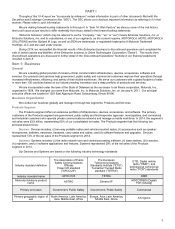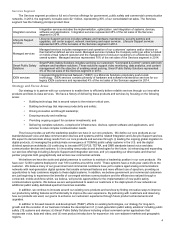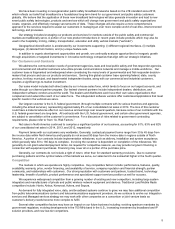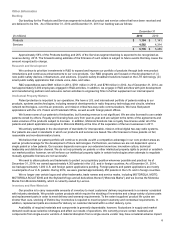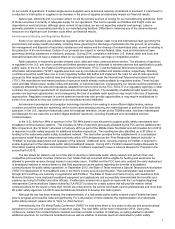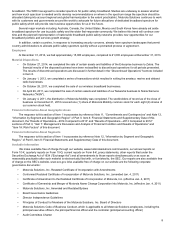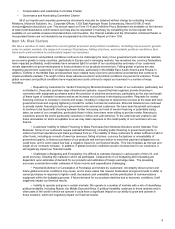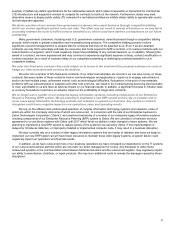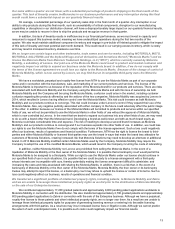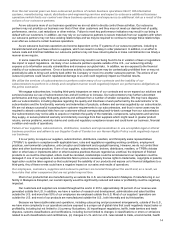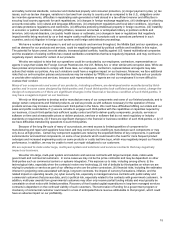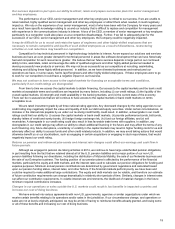Motorola 2014 Annual Report Download - page 15
Download and view the complete annual report
Please find page 15 of the 2014 Motorola annual report below. You can navigate through the pages in the report by either clicking on the pages listed below, or by using the keyword search tool below to find specific information within the annual report.13
Our sales within a quarter are not linear, with a substantial percentage of products shipping in the final month of the
quarter. This lack of linearity creates inefficiencies in our business performance and any interruption during this final
month could have a substantial impact on our quarterly financial results.
On average, a substantial percentage of our quarterly sales ship in the final month of a quarter. Any interruption in our
ability to ship products during this final month, such as unavailability of critical components, disruption to our manufacturing
capabilities or disruptions in our distribution channel, will have a disproportionately large impact on our quarterly financial results,
as we may be unable to recover in time to ship the products and recognize revenue in that quarter.
In addition, this lack of linearity results in inefficiencies in our financial performance, as we must invest in capacity and
resources to support this business model, meaning we have underutilized operations during the first two months of the
quarter. We also must maintain additional component inventory and engage in pre-builds of finished goods to mitigate the impact
of this lack of linearity and meet potential last month demand. This could result in our carrying excess inventory, which is costly
and may result in increased inventory obsolesce over time.
We no longer own certain logos and other trademarks, trade names and service marks, including MOTOROLA, MOTO,
MOTOROLA SOLUTIONS and the Stylized M logo and all derivatives and formatives thereof (“Motorola Marks”) and we
license the Motorola Marks from Motorola Trademark Holdings, LLC (“MTH”), which is currently owned by Motorola
Mobility, a subsidiary of Lenovo. Our joint use of the Motorola Marks could result in product and market confusion and
negatively impact our ability to expand our business under the Motorola brand. In addition, if we do not comply with
the terms of the license agreement we could lose our rights to the Motorola Marks. Because of the change of control of
Motorola Mobility, which is now owned by Lenovo, we may find that an incompatible third-party owns the Motorola
Marks.
We have a worldwide, perpetual and royalty-free license from MTH to use the Motorola Marks as part of our corporate
name and in connection with the manufacture, sale, and marketing of our current products and services. The license of the
Motorola Marks is important to us because of the reputation of the Motorola brand for our products and services. There are risks
associated with both Motorola Mobility and the Company using the Motorola Marks and with this loss of ownership. As both
Motorola Mobility and the Company will be using the Motorola Marks, confusion could arise in the market, including customer
confusion regarding the products offered by and the actions of the two companies. Motorola Mobility was acquired by Lenovo in
2014, which resulted in Lenovo having effective control over the Motorola Marks. This risk could increase as both Motorola
Mobility's and our products continue to converge. This risk could increase under Lenovo's control if they expand their use of the
Motorola Marks. Also, any negative publicity associated with either company in the future could adversely affect the public image
of the other. In addition because our license of the Motorola Marks will be limited to products and services within our specified
fields of use, we will not be permitted to use the Motorola Marks in other fields of use without the approval of Motorola Mobility,
which is now controlled by Lenovo. In the event that we desire to expand our business into any other fields of use, we may need
to do so with a brand other than the Motorola brand. Developing a brand as well-known and with as much brand equity as
Motorola could take considerable time and expense. The risk of needing to develop a second brand increases as Motorola
Mobility's and our products continue to converge and if our business expands into other fields of use. In addition, we could lose
our rights to use the Motorola Marks if we do not comply with the terms of the license agreement. Such a loss could negatively
affect our business, results of operations and financial condition. Furthermore, MTH has the right to license the brand to third-
parties and either Motorola Mobility or licensed third-parties may use the brand in ways that make the brand less attractive for
customers of Motorola Solutions, creating increased risk that Motorola Solutions may need to develop an alternate or additional
brand. In 2013 Motorola Mobility modified certain Motorola Marks used by the Company. Motorola Mobility may require the
Company to adopt the use of the modified Motorola Marks, which would result in the Company incurring the costs of rebranding.
In addition, neither Motorola Mobility nor Lenovo are prohibited from selling the Motorola Marks. In the event of a
liquidation of Motorola Mobility or the then owner of the Motorola Marks, it is possible that a bankruptcy court would permit the
Motorola Marks to be assigned to a third-party. While our right to use the Motorola Marks under our license should continue in
our specified field of use in such situations, it is possible that we could be party to a license arrangement with a third-party
whose interests are incompatible with ours, thereby potentially making the license arrangement difficult to administer, and
increasing the costs and risks associated with sharing the Motorola Marks. In addition, there is a risk that, in the event of a
bankruptcy of Motorola Mobility or the then owner of the Motorola Marks, Motorola Mobility, the then owner or its bankruptcy
trustee may attempt to reject the license, or a bankruptcy court may refuse to uphold the license or certain of its terms. Such a
loss could negatively affect our business, results of operations and financial condition.
We transferred a significant portfolio of intellectual property rights, including patents, to Motorola Mobility and Zebra
and we are unable to leverage these intellectual property rights as we did prior to the distribution of Motorola Mobility
or the sale of our Enterprise business.
We contributed approximately 17,200 granted patents and approximately 8,000 pending patent applications worldwide to
Motorola Mobility in connection with the distribution. We also transferred approximately 2,700 granted patents and approximately
800 pending patent applications to Zebra in connection with the sale of the Enterprise business. Although we have a perpetual,
royalty-free license to these patents and other intellectual property rights, we no longer own them. As a result we are unable to
leverage these intellectual property rights for purposes of generating licensing revenue or entering into favorable licensing
arrangements with third-parties. As a result we may incur increased license fees or litigation costs. Although we cannot predict
the extent of such unanticipated costs, it is possible such costs could negatively impact our financial results.


